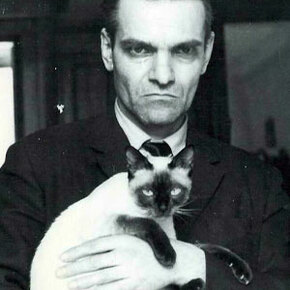
35 Random Historical Photos Shared On ‘History Everyday’ Instagram Account That Might Interest History Lovers
If you’re a fan of quirky, bizarre, random, and downright fascinating historical snapshots, then you’re in for a treat. We’re about to embark on a journey back in time, courtesy of everyone’s favorite time-traveling app: Instagram.
Yes, you read that right! ‘History Everyday,’ the Instagram account that’s here to make your history lessons way more fun, is about to drop some historical knowledge bombs on you. Buckle up, because these photos are gonna blow your socks off!
More info: Instagram
#1

Image source: historyfromeveryday
On 23rd August, 1989, 2 million people in Lithuania, Estonia and Latvia held hands and formed a human chain 675.5 kilometers (420 miles) long, protesting against Soviet oppression and their desire to escape communism.
#2

Image source: historyfromeveryday
WW1 veteran runs alongside the coach of King George V to ask for money, 1920. It’s surprising that anyone could get so close to the king, considering that just six years previous Archduke Ferdinand had been assassinated by a man running up to his carriage, triggering WW1.
#3

Image source: historyfromeveryday
A Leading Stoker nicknamed “Popeye” with 21 years in service and fighting aboard the HMS Rodney, taken in 1940. “Stoker” remains the colloquial term used to refer to a Marine Engineering rating in the Royal Navy.
#4

Image source: historyfromeveryday
In 1731 King Frederick I of Sweden was gifted a lion, one of the first lions in Scandinavia. When the lion died shortly after, it was given to a taxidermist and this was the end product. The taxidermist and the museum keepers had never actually seen a lion before, and did not know how they were supposed to look. As a result, the resulting mount was especially anatomically inaccurate, most apparent in its face.
#5

Image source: historyfromeveryday
This colorized photo shows the Montparnasse derailment that occurred on the 22nd October 1895 in Paris. With the train several minutes late and the driver trying to make up for lost time, it entered the station too fast and the trains air brake failed to stop it. After running through the buffer stop, the train crossed the station concourse and crashed through the station wall. The locomotive fell onto the Place de Rennes, shown in this photo, where it stood on its nose. A woman in the street below was killed by falling masonry.
#6

Image source: historyfromeveryday
On August 8th 1982 a line drive foul ball hits a four year old boy, Jonathan Keane, in the head at Fenway Park. Jim Rice, realizing in a flash that it would take EMTs too long to arrive and cut through the crowd, sprang from the dugout and scooped up the boy. He laid the boy gently on the dugout floor, where the Red Sox medical team began to treat him. When the boy arrived at the hospital 30 minutes later, doctors said Jim’s prompt actions were instrumental in saving the boy’s life. Jim returned to the game in a blood stained uniform. A real badge of courage. After visiting the boy in the hospital, and realizing the family was of modest means, he stopped by the business office and instructed that the medical bill be sent to him. The spring following the incident, Jonathan was asked to throw the ceremonial first pitch for the Red Sox’s home game opener. He gladly accepted and had the opportunity to reconnect with Rice.
#7

Image source: historyfromeveryday
Escape artist Harry Houdini locked up in chains about to take a 30 foot plunge off the Harvard Bridge into the Charles River in Boston, 1908. Houdini is quoted as saying “there is always the possibility that I will be unable to free myself, as one never can tell what will happen to a lock, however, I am a good swimmer, have confidence in myself, and I hope to perform this feat successfully.” Some 20,000 spectators gathered to see Houdini’s leap, including the mayors of Boston and Cambridge. They waited 40 seconds for the magician to resurface, which he did with the shackles in his hands.
#8

Image source: historyfromeveryday
While British Airways Flight 5390 was flying over Didcot, Oxfordshire in 1990, an improperly installed windscreen panel separated from its frame causing the captain, Timothy Lancaster, to be sucked out of the aircraft. The captain was held in place through the window frame for twenty minutes, as shown in this reenactment image, until the first officer landed at Southampton Airport. Lancaster survived with frostbite, bruising, shock, and fractures to his right arm, left thumb, and right wrist. Flight attendant Nigel Ogden, who helped hold Lancaster in place, had cuts and bruises to his arm, and later suffered from PTSD. There were no other injuries.
#9

Image source: historyfromeveryday
Old Croghan Man is a well preserved Irish Iron Age body found in June 2003, who is believed to have died between 362 BC and 175 BC. The man is calculated (based on his arm span) to have stood approximately 6 ft 6 in (1.98 m) tall, which is considered to be exceptionally tall for the period when he lived. His last meal (analysed from the contents in his stomach) was believed to have been wheat and buttermilk. However, he was shown to have had a meat rich diet for at least the 4 months prior to his death.
#10

Image source: historyfromeveryday
This photo shows coal miners in Belgium crammed in a mine elevator coming up after a long days work in 1900.
#11

Image source: historyfromeveryday
These 3 Jewish men arrived in Auschwitz on the same day and were tattooed 10 numbers apart. 73 years later they are photographed meeting for the first time for the Last Eyewitness Project, as free men who survived to build families and prosperous lives.
#12

Image source: historyfromeveryday
Simo Häyhä, also known as The White Death, was a Finnish sniper in WW2 during the 1939–1940 Winter War against the Soviet Union. Here are some facts about him: He had 500 confirmed kills in less than 100 days. He used no scope on his rifle. He held off 4,000 Soviets with only 31 other Finns. He was shot in the jaw with an exploding bullet, which ended his career. He survived and lived to the age of 96.
#13

Image source: historyfromeveryday
The first ever photograph of a person, taken in 1838 in Paris. Look to the bottom left of the frame. There is a man having his shoes shined. That man is the earliest known photograph of a recognizable human being, taken by Louis Daguerre. It wasn’t that the man in question was the only person on the street. More than likely, the street was full of horses and carts and pedestrians going about their business. It was rather that the exposure time for the image was around ten minutes, which meant that everything else in the scene was moving too fast to be captured in any clarity.
#14

Image source: historyfromeveryday
Albert Einstein playing the violin, circa 1930. In 1929, Albert Einstein told the Saturday Evening Post, “If I were not a physicist, I would probably be a musician.” By then Einstein was world renowned for his theory of relativity, but only a few knew that his biggest joy in life was music. He had played piano and violin since childhood.
#15

Image source: historyfromeveryday
The Great Blizzard of 1888 was one of the most severe recorded blizzards in American history. The storm paralyzed the East Coast, with snow from 10 to 58 inches (25 to 147 cm) in parts of New Jersey, New York, Massachusetts, Rhode Island, and Connecticut. The photograph shows an unidentified young man standing in a shoveled area on Madison Avenue and 40th Street in New York City. Railroads were shut down and people were confined to their homes for up to a week. Railway and telegraph lines were disabled, and this provided the motivation to move these pieces of infrastructure underground.
#16

Image source: historyfromeveryday
Last photo of Hachikō, a Japanese Akita dog remembered for his remarkable loyalty to his owner, Hidesaburō Ueno, for whom he continued to wait for over nine years following Ueno’s death. In 1924, Hidesaburō Ueno, a professor at the Tokyo Imperial University, brought him to live in Shibuya, Tokyo, as his pet. Hachikō would meet Ueno at Shibuya Station every day after his commute home. This continued until May 21, 1925, when Ueno died of a cerebral hemorrhage while at work. From then until his death on March 8, 1935, Hachikō would return to Shibuya Station every day to await Ueno’s return.
#17

Image source: historyfromeveryday
Ann Elizabeth Fowler Hodges, the first documented individual to not only be struck by a meteorite but also live through the encounter in 1954. The grapefruit sized fragment crashed through the roof of her farm house, bounced off a large wooden console radio, and hit Hodges while she napped on a couch. The 34 year old woman was badly bruised on one side of her body, but was able to walk. The event received worldwide publicity.
#18

Image source: historyfromeveryday
Young oyster shuckers in South Carolina, 1912. Josie, 6 years old, Bertha, 6 years old, and Sophie, 10 years old, began work at 4am.
#19

Image source: historyfromeveryday
The Michelin Man, official sponsor of the Michelin tire company, in 1920. Fun fact: The restaurant rating system ‘Michelin Stars’ also originated from this. Michelin began reviewing restaurants so that more people would travel further distances in their cars to eat at restaurants. This in turn would wear down their tires faster, and force them to buy more. The Michelin star system goes up to three and has the following criteria: 1 star: “A very good restaurant in its category”. 2 stars: “Excellent cooking, worth a detour”. 3 stars: “Exceptional cuisine, worth a special journey”.
#20

Image source: historyfromeveryday
Japanese archers, circa 1860. The men are practitioners of Kyudo, which is the Japanese martial art of archery. The Japanese bow (Yumi) used is exceptionally tall, surpassing the height of the archer.
#21

Image source: historyfromeveryday
Two boys make a trade in Kenya, 1962. 9 year old Kevin from New York had come to Kenya to join his stepfather as guest of a Maasai tribe, where he and the chief’s son Dionni became close companions. “The Maasai taught me lots of things,” Kevin wrote in his diary. “They are very nice people and we had no problems understanding each other. They taught me to shoot the heaviest bow I have ever seen and I taught Dionni how to play baseball and write his name. He doesn’t speak any English and I learned 11 words in Swahili.”
#22

Image source: historyfromeveryday
RMS Queen Elizabeth pulling into New York at the end of WW2 with returning soldiers, 1945. Her carrying capacity was over 15,000 troops and over 900 crew. While it may look overcrowded, it is because everyone was on deck as the ship pulled into the harbor.
#23

Image source: historyfromeveryday
16 year old German soldier, Hans-Georg Henke, crying as he is captured by the US 9th Army in Germany on April 3rd, 1945. He was a member of the Luftwaffe anti-air squad and burst into tears as his world crumbled around him. His father died in 1938, but when his mother died in 1944 leaving the family destitute, Hans-Georg had to find work in order to support the family. At 15 years of age he joined the Luftwaffe.
#24

Image source: historyfromeveryday
900 year old Crusader sword found off Israel’s northern coast in October 2021. The iron sword is just under 4 ft. long and is presumed to have belonged to a Crusader sailing to the Holy Land in approximately the year 1100.
#25

Image source: historyfromeveryday
A beach in Iran a few months before the Islamic Revolution of 1978/79.
#26

Image source: historyfromeveryday
The bride who refused to let her wedding day be stolen by the Blitz bombing of London in 1940. The Blitz was a German bombing campaign against the United Kingdom in 1940 and 1941, during WW2. The Germans conducted mass air attacks against industrial targets, towns, and cities, beginning with raids on London towards the end of the Battle of Britain in 1940.
#27

Image source: historyfromeveryday
A woman kneels beside the bed of a child in an underground tunnel during the bombing of London in WW2. London built a whole underground tunnel infrastructure to protect citizens during bombing attacks in WW2. They were called London deep level shelters, which were eight deep level air raid shelters that were built under London Underground stations. The final capacity in each was around 8,000 people. The shelters were started in 1940 during the Blitz in response to public demand to shelter in the London Underground stations. However, they were not completed until 1942 after the Blitz was over, so they were initially all used by the government, but as bombing intensified five of them were opened to the public in 1944.
#28

Image source: historyfromeveryday
A woman is held captive in a wooden crate and left to die of starvation in a remote desert in Mongolia, 1913. It was capital punishment for committing adultery. Stéphane Passet was touring Mongolia and taking pictures in 1913, when he came across the Mongolian woman in a box. In the photograph you can see two bowls on the ground for water and food. She was given food and water not on a daily basis but in a way to prolong her suffering. In order not to alter the balance of local laws and civilizations of Mongolia, or in another words get himself in trouble, Stéphane Passet Left the woman in the box.
#29

Image source: historyfromeveryday
A Senegalese WW1 soldier who lost both his arms writes a letter with his new prosthetic limbs at the Vocational Rehabilitation School for Amputees in Paris, 1918. He was part of the Senegalese Tirailleurs, a corps of colonial infantry in the French Army.
#30

Image source: historyfromeveryday
This photo from 1908 shows 11 year old coal miner Otha Porter Martin at the Turkey Knob Mine in West Virginia. As a ‘tipple boy’ his job would be to load coal for transport, typically into railroad hopper cars. Otha went on to live a long life until passing away in 1985.
#31

Image source: historyfromeveryday
Two childhood friends unexpectedly reunite on opposite sides of a demonstration in 1972. True story. Long before Jacques Gourmelen took this photo on April 6th 1972 in Saint-Brieuc, France, the worker, Guy Burmieux, and the riot policeman, Jean-Yvon Antignac, had grown up together. The two had gone to high school together. Partied together. One article called them “best friends.” Guy himself is quoted as calling them “inseparable.”
#32

Image source: historyfromeveryday
Adam Rainer was born in 1899 in Austria. He holds an unusual distinction in medical history. He’s known as the only person that was both a dwarf and a giant. From birth into adulthood Rainer was always short and stood at just 3 foot 8 inches at the age of 19. But at 21 he began a growth spurt, due to a tumor on his pituitary gland, that made him over seven feet tall just 10 years later.
#33

Image source: historyfromeveryday
The famous 1930 painting “American Gothic” by Grant Wood depicts a farmer standing beside his daughter, often mistakenly assumed to be his wife. The painting is named for the house’s architectural style in the background. The two faces in the painting were actually modeled by Wood’s sister Nan Wood Graham and their dentist Dr. Byron McKeeby (shown above).
#34

Image source: historyfromeveryday
A mother and child during the Great Depression, 1939. This photo was taken by Dorothea Lange in Tulelake, California. During the Great Depression Lange photographed unemployed and migrant workers, showing some of the horrible conditions they lived in.
#35

Image source: historyfromeveryday
US Army technician Alvin Harley receives a kiss from a liberated French girl on Valentine’s Day, 1945.


















Got wisdom to pour?